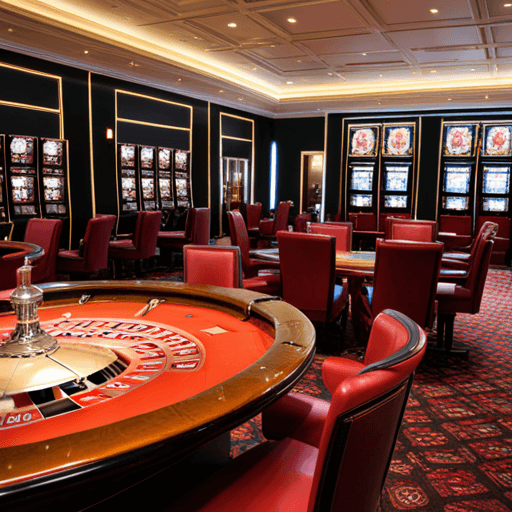
In a lively and exciting world of casinos, wherein fortune and strategy intertwine, hues and design play a pivotal role in attracting gamblers. As soon as players step inside a casino or log into a gaming website, they are enveloped in a visual feast that grabs their attention and entices them to explore more. https://ga179.xyz/ Vivid colors, captivating graphics, and creative layouts are carefully crafted to create an atmosphere of excitement and anticipation, ultimately enhancing the gaming experience.
As gamblers move through the dynamic landscape of casino games, they encounter a variety of designs that not only serve visual purposes but also influence feelings and decision-making. Colors like scarlet and yellow symbolize riches and fortune, while soothing blues and greens can create a much relaxed environment. Grasping how these elements function together enables casinos to create an inviting and energizing atmosphere that encourages players to interact with the games, invest additional time at the tables, and boost their general enjoyment.
The Psychology of Color in Casino Games
Color plays a critical role in the creation of casino games, shaping players’ emotional states and responses. Vivid and bold shades, such as scarlet and yellow, are often used to stimulate enthusiasm and attract attention. These colors create a sense of urgency and energy, encouraging participants to engage more enthusiastically with the experience. By thoughtfully selecting hues, designers aim to inspire emotions of pleasure and anticipation, which can enhance the complete game experience.
Different shades also have psychological connotations that can impact how gamblers perceive their possibilities of winning. For instance, lime is frequently associated with luck and wealth, making it a frequent choice in activities like roulette and poker tables. This connection can result participants to feel more positive and assured in their play, ultimately inspiring them to bet more. Comprehending these associations allows game designers to design environments that enhance player enjoyment and engagement.
Furthermore, the interface of gambling game interfaces often uses color gradients and differing hues to instruct player actions. For instance, winning results may be emphasized with striking, opposing shades, creating a visual cue. This technique supports favorable outcomes and encourages repeated participation. By utilizing the science of color, casinos can create games that not only captivate players but also keep them involved and invested in their play experience.
Design Features that Engage Players
The aesthetic appeal of gambling games is largely influenced by the implementation of vibrant colors. Bright and striking colors are deliberately chosen to create an inviting atmosphere that grabs interest. For example, reds and golden hues often signify luck and wealth, which is why they are prevalent in the color schemes of slot machines and game surfaces. These colors not only attract players in, but they also evoke emotions related to excitement and expectation, enhancing the overall gaming experience.
In parallel to color, the design and layout of gambling games play a crucial role in captivating players. Games are designed to be user-friendly, ensuring that players can easily understand the guidelines and mechanics. Accessible interfaces, along with engaging graphics and motion, help maintain gamer interest and promote longer play sessions. The tactile elements, such as the feel of the buttons and the sounds of the games, also add to a comprehensive sensory experience that keeps players engaged.
Finally, thematic elements in gaming design can significantly influence player choice. Many casino games are inspired by popular culture, myths, or adventure themes, featuring symbols and characters that resonate with players. These themes create a sense of immersion and connection, making each game feel distinct. When players feel a bond to the concept, they are more likely to opt for that game over others, leading to increased participation and enthusiasm within the casino environment.
Case Studies: Successful Casino Game Designs
One key example of successful casino game design is the well-known slot machine series themed around popular movies. Games such as those based on the Wizard of Oz and Game of Thrones utilize dynamic colors and top-notch graphics to immerse players in recognizable narratives. The employment of dynamic visuals and entertaining sound effects takes the focus of players, establishing an affective connection to the theme. This approach not just encourages longer play but also improves the overall gaming experience, resulting in increased player retention.
Another notable case is the application of color psychology in table games like 21 and roulette. Casinos often design these games with deep reds and greens, colors traditionally connected with luck and wealth. For instance, the emerald felt on a blackjack table provides a soothing effect, while the crimson accents in roulette invite anticipation. This deliberate use of color helps to establish an inviting atmosphere that motivates players to join in, satisfying their psychological impulses and boosting their enjoyment.
Finally, social casino games that include community features and vivid, colorful designs have seen remarkable success in engaging players. Games like Zynga’s Poker and Slot-O-Mania leverage striking colors and playful animations to create an inviting online environment. The integration of leaderboards, community sharing options, and in-app rewards fosters competition and community, pulling players in for longer sessions. Such designs not only make the games visually attractive but also emphasize social connectivity, a vital factor in player retention and engagement within online casino environments.
